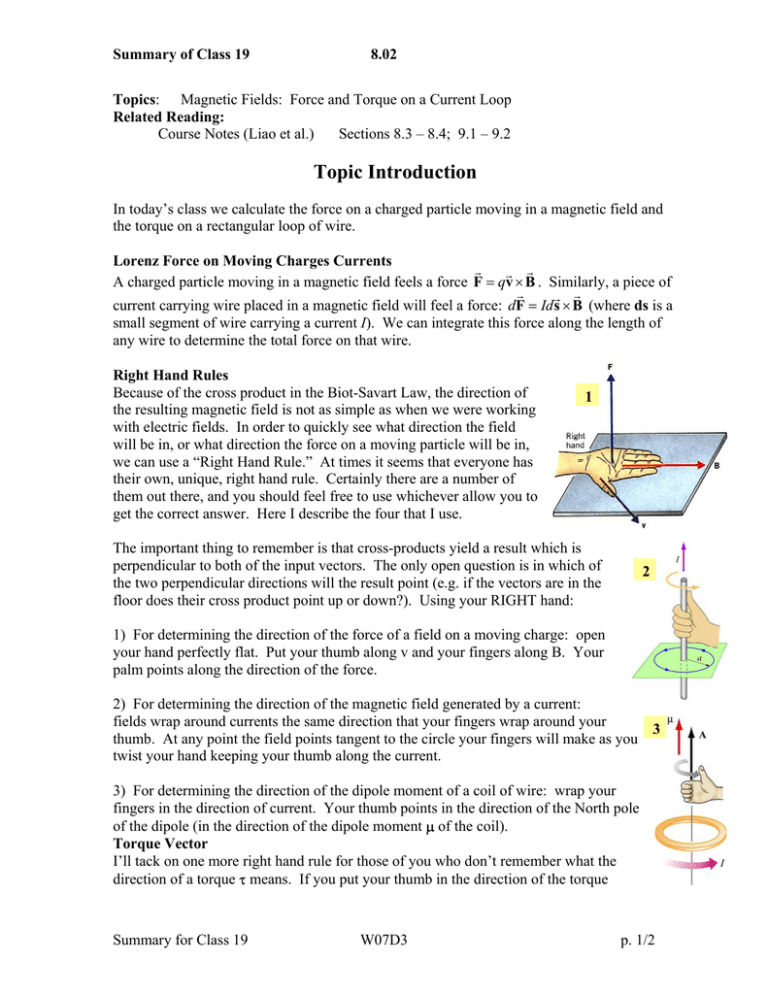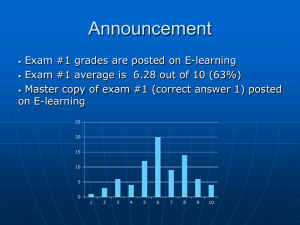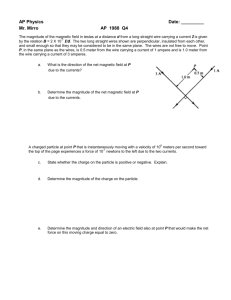Summary of Class 19 8.02 Topics Related Reading:
advertisement

Summary of Class 19 8.02 Topics: Magnetic Fields: Force and Torque on a Current Loop Related Reading: Course Notes (Liao et al.) Sections 8.3 – 8.4; 9.1 – 9.2 Topic Introduction In today’s class we calculate the force on a charged particle moving in a magnetic field and the torque on a rectangular loop of wire. Lorenz Force on Moving Charges Currents G G G A charged particle moving in a magnetic field feels a force F = qv × B . Similarly, a piece of G G G current carrying wire placed in a magnetic field will feel a force: dF = Id s × B (where ds is a small segment of wire carrying a current I). We can integrate this force along the length of any wire to determine the total force on that wire. Right Hand Rules Because of the cross product in the Biot-Savart Law, the direction of the resulting magnetic field is not as simple as when we were working with electric fields. In order to quickly see what direction the field will be in, or what direction the force on a moving particle will be in, we can use a “Right Hand Rule.” At times it seems that everyone has their own, unique, right hand rule. Certainly there are a number of them out there, and you should feel free to use whichever allow you to get the correct answer. Here I describe the four that I use. 1 The important thing to remember is that cross-products yield a result which is perpendicular to both of the input vectors. The only open question is in which of the two perpendicular directions will the result point (e.g. if the vectors are in the floor does their cross product point up or down?). Using your RIGHT hand: 2 1) For determining the direction of the force of a field on a moving charge: open your hand perfectly flat. Put your thumb along v and your fingers along B. Your palm points along the direction of the force. 2) For determining the direction of the magnetic field generated by a current: fields wrap around currents the same direction that your fingers wrap around your 3 thumb. At any point the field points tangent to the circle your fingers will make as you twist your hand keeping your thumb along the current. 3) For determining the direction of the dipole moment of a coil of wire: wrap your fingers in the direction of current. Your thumb points in the direction of the North pole of the dipole (in the direction of the dipole moment µ of the coil). Torque Vector I’ll tack on one more right hand rule for those of you who don’t remember what the direction of a torque τ means. If you put your thumb in the direction of the torque Summary for Class 19 W07D3 p. 1/2 Summary of Class 19 8.02 vector, the object being torque will want to rotate the direction your fingers wrap around your thumb (very similar to RHR #2 above). Important Equations Force on Moving Charges in Magnetic Field: Force on Current-Carrying Wire Segment: Magnetic Moment of Current Carrying Wire: Torque on Magnetic Moment: ( Force on Magnetic Moment: Energy of Moment in External Field: Summary for Class 19 G G G F = qv × B G G G dF = Id s × B G G µ = IA (direction for RHR #3 above) G G G τ = µ×B G G G G FDipole = µ ⋅∇ B G G U = −µ ⋅ B W07D3 ) p. 2/2






